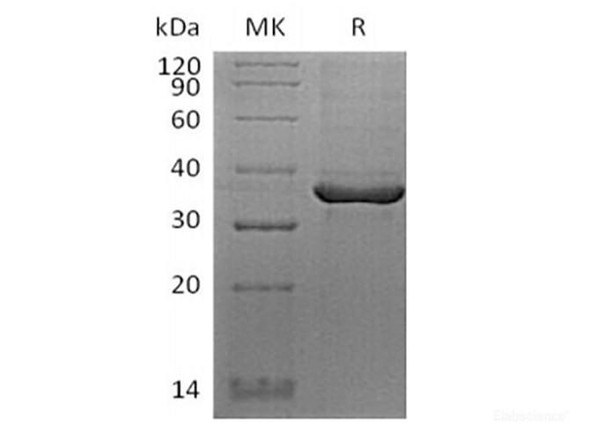Description
| Product Name: | Recombinant Human PDCD1/PD-1/CD279 (C-6His-Avi) Biotinylated |
| Product Code: | RPES6205 |
| Size: | 20µg |
| Species: | Human |
| Expression Host: | HEK293 Cells |
| Synonyms: | Programmed cell death protein 1, hPD-1, PDCD1, CD279 |
| Mol Mass: | 19.2 kDa |
| AP Mol Mass: | 35-45 kDa |
| Tag: | C-6His-Avi |
| Purity: | > 95 % as determined by reducing SDS-PAGE. |
| Endotoxin Level: | < 1.0 EU per μg of the protein as determined by the LAL method. |
| Bio Activity: | Testing in progress |
| Sequence: | Pro21-Gln167 |
| Accession: | Q15116 |
| Storage: | Generally, lyophilized proteins are stable for up to 12 months when stored at -20 to -80°C. Reconstituted protein solution can be stored at 4-8°C for 2-7 days. Aliquots of reconstituted samples are stable at < -20°C for 3 months. |
| Shipping: | This product is provided as lyophilized powder which is shipped with ice packs. |
| Formulation: | Lyophilized from a 0.2 μm filtered solution of PBS, pH 7.4. Normally 5 % - 8 % trehalose, mannitol and 0.01% Tween80 are added as protectants before lyophilization. Please refer to the specific buffer information in the printed manual. |
| Reconstitution: | Please refer to the printed manual for detailed information. |
| Background: | Programmed cell death protein 1(PDCD1) is a single-pass type I membrane protein and contains 1 Ig-like V-type domain. PD-1 is a member of the extended CD28/CTLA-4 family of T cell regulators. PDCD1 inhibits the T-cell proliferation and production of related cytokines including IL-1, IL-4, IL-10 and IFN-γ by suppressing the activation and transduction of PI3K/AKT pathway. In addition, coligation of PDCD1 inhibits BCR-mediating signal by dephosphorylating key signal transducer. PDCD1 has been suggested to be involved in lymphocyte clonal selection and peripheral tolerance, and thus contributes to the prevention of autoimmune diseases. As a cell surface molecule, PDCD1 regulates the adaptive immune response. Engagement of PD-1 by its ligands PD-L1 or PD-L2 transduces a signal that inhibits T-cell proliferation, cytokine production, and cytolytic function. |






